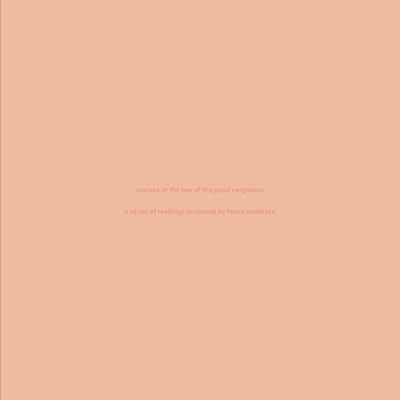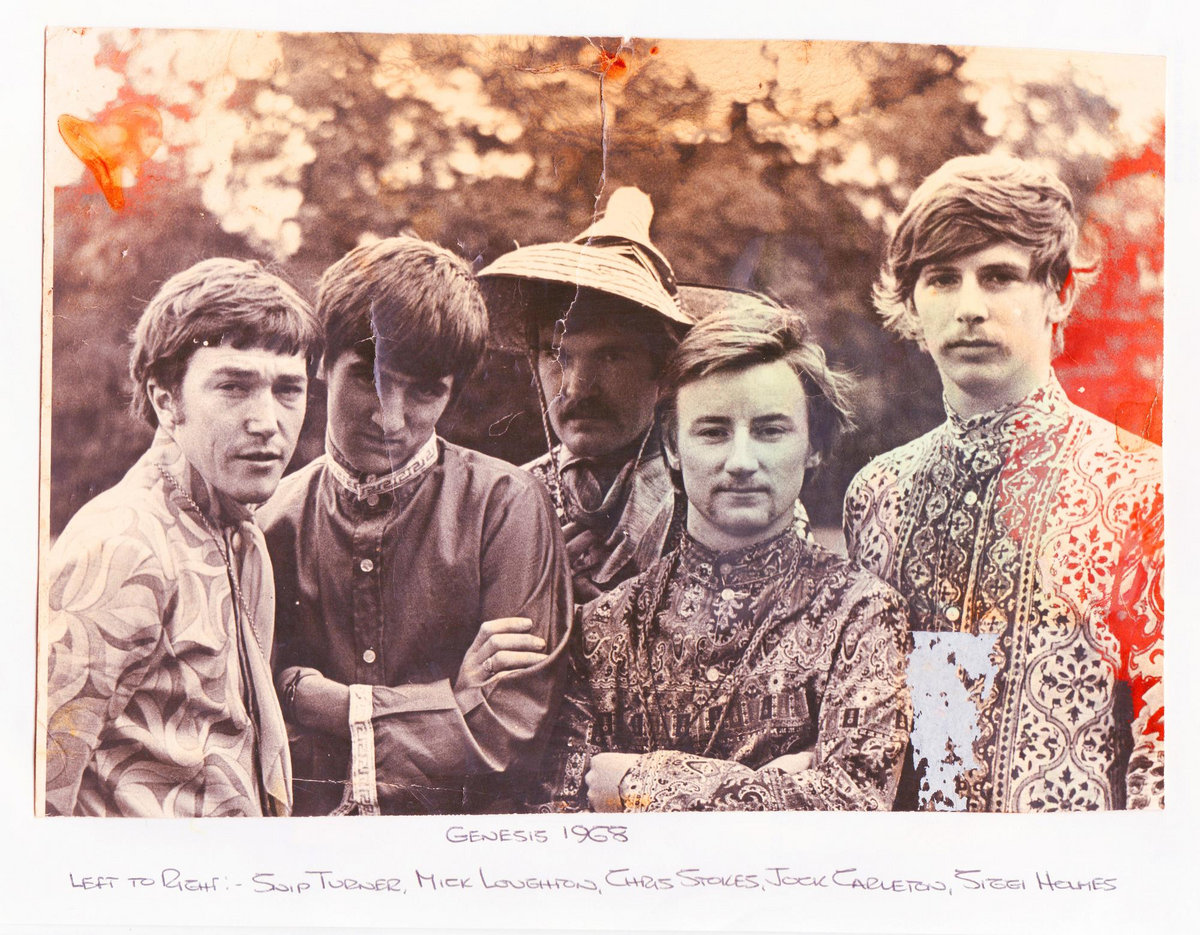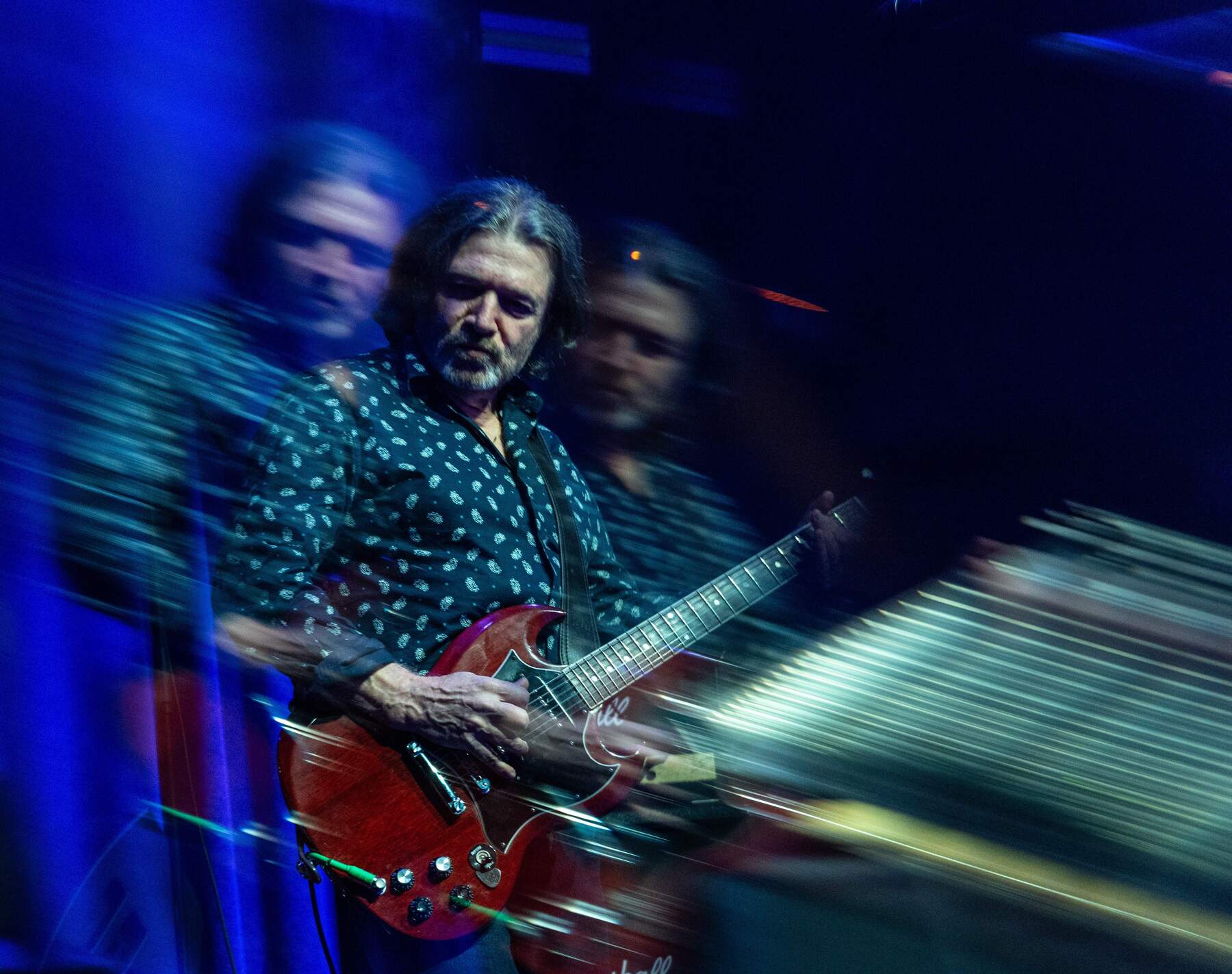Henry Andersen
“There is information and communities in the world which you just cannot access, and that this is OK”
Henry Andersen’s debut album Stanzas or The Law of the Good Neighbour is a record on which every word counts. It’s a list of words, read out loud.
You made a concept record about a world play. Can you tell me, in your own words: what’s the concept? And what’s the game about? What are the rules of the game? Is this a self-invented game?
The game is very simple. Each word should be a sound-alike of the word that comes before it. So for example “human” leads to “hammon” leads to “harmon” leads to “mormon” and so on. Beyond this rule, the choice of words is pretty freely associative. The list reflects the words I know and which are in the air around me. I think it’s important that the formal construction stays very simple, both for the listener (so it’s easy to follow) and for myself (so there I can write quickly and it stays something fun for me to do). I also try to include a few combinations that don’t really “work” according to the rule – where the sounds are quite far apart. Otherwise, you end up a slave to your own formal system.
I didn’t take the idea of this word game from anywhere necessarily, but at the same time I’m sure I didn’t invent it. In a sense, it’s not the form which is important but the choice of words. Anyone who would play this same game would use her or his own vocabulary. It’s possible to read a kind of “meaning” from the list, but you have to take the choice of words as a sum total and not get too bogged down by any particular word or combination (though these can be a fun way to make jokes).
I’ve been writing the list intermittently now for around 2 years. For me it’s interesting to look back at material I was writing from a while back, like when I was living in Germany for example, and notice how much my choice of words has changed. There are a lot of place names and foreign words which for me are always very clear reminders of what I was doing / reading / thinking about at any particular moment.
Who are the people who read your text on your record? Just friends?
The list is always read by friends of mine. On the record, you hear the voices of Eleanor Weber, Ailsa Cavers, Simon Ascencio and Sébastian Capouet. For the record, I put together 5 different pairs of friends and we recorded everything over two days in Schaarbeek. Because the takes are so long, and the readers are mostly non-professionals, it’s very hard to predict what qualities each combination of readers will give. We recorded about 12 versions using different sections of the list and then I picked two pairs who I thought gave interesting, complementary readings.
For me, it’s important that this piece is read by friends of mine. The choice of readers is as or more important for me than the choice of words. It reflects the people around me just as the text itself reflects the words around me. I’ve been organising readings and recordings of the list more or less since it began, almost like an ethnography tracking particular moments in particular relationships which are important to me. There is now a pretty large and interesting community of people who have offered their time to give readings over the last 2 years. Most of them have their own practices as artists, musicians, dancers etc. For the record launch in May we will try to bring as many of them as possible together and curate a kind of exhibition of their work – to show the readers as a kind of imaginary community around the record, not just as voices who helped me realise my own ideas.
The text is in English, but only the woman who starts the reading seems to have English as her first language (the others sound like French is their first language). Why did you choose people who don’t have English as their first language to read the text?
There is of course a big difference between readers who speak English as their first language and foreign speakers. So mostly when I organise readings with English speakers, the words themselves are more “at the surface”, when it is read by foreign readers there is some more visceral sense of the sound and slight unfamiliarity to the pronunciation. I tend not to pair native and non native speakers for the readings because it sets up a power dynamic that I don’t find interesting. So on the record Eleanor and Ailsa are both native speakers (from Australia and from England) and Simon and Sebastian are both francophone (from France and Belgium).
In my day to day life, I mostly speak English with the people around me, but more-often-than-not I’m still speaking with people who have learned English as a second language. Personally, I think the most interesting thing about English is how it sounds when being spoken by foreigners. It can generate a whole host of surprises and strangenesses which the language itself somehow accommodates very well. For the record, I would never want to set up some kind of system where the mispronunciations are the “point” of the piece, but at the same time I want that the piece can accommodate them and that they can bring something unexpected for me and the listener. It’s not about reading the list “well”, but about what each reader brings to it.
The words of your text are mostly read by two people at once, but not completely simultaneously. Why not completely simultaneously?
I ask the readers to try to read together as much as possible, and to match their rhythm and volume to one another. At the same time though, we deliberately try not to rehearse very much because I’m interested in what happens when people fail to achieve such a task. It’s the same reason that I try to make pairings of people that have different relationships with each other; couples, friends, people who have never met. I think the interesting thing for me about the record is listening to these dynamics play out – to see who is setting the rhythm, or how people adjust to one another. In a sense, the list is just an interface to hear these micro-details in how the two readers relate.
Why did you decide to split the record up into a male (the B side) and a female side (the A side)?
Certainly not to make any political point. At one moment when I was choosing the takes, the record looked like it would be all women, but I also liked to have some male voices on it because the lower frequencies interact in a way that higher frequencies don’t. I think that its important to be aware of gender politics when making any piece that has to do with voices or bodies, but for this piece there is no conscious choice to deal with equal representation or something like this.
I listened to the record from start to finish, but I still don’t get what the title The Law of the Good Neighbour has to do with what I hear on the record, so you have to explain it to me.
The full title of the piece is Stanza or The Law of the Good Neighbour. It’s a kind of a red herring though. Basically, I first started writing a version of this piece when I was working on a series called Stanzas. Every piece in the series was about taking two different kinds of materials and putting them together without any clear idea about what the result would be. I wanted to extend this logic to the titles too.
I started collecting up little phrases that stuck out to me when I was reading or that I found in songs or written on bathroom walls or wherever. This collection became a bank of possible titles. So anytime I finish a piece, I can scan the list and pick a title that seems to fit in some way that was not too prescriptive. It was a bit like wanting to call the piece “untitled”, but of course now if you call a piece “untitled” you are referring to a very long history of pieces that have this name. So The Law of the Good Neighbour is just something that I read somewhere and that I wanted to throw into the mix somehow. What’s funny about it to me is that the more the piece has developed, the more it seems to describe to me what the piece is about. So the piece just grew to resemble it’s name, rather than the other way around.
There are a lot of references to culture and pop culture in your list of words. Why is that, you think? Because pop culture is part of our everyday life? Because pop culture is the main culture of our Western society?
Sure. The list is meant to just reflect the things that I am interested in and thinking about. Pop culture is a part of my life and I don’t see any reason to ignore this or deny it when I’m making a “proper” piece of art. There is a lot of so-called “high” culture that I deeply care about – conceptual art, architecture, politics, Lacan, Benjamin – but I’m equally invested in hip-hop, advertising slogans, Young Thug, club culture, fashion etc. If I’m just listing words that are in the air around me. I think it’s dishonest to deliberately leave out any part of that spectrum.
When Rashad Becker released his first record, he gave an interview where he talked about travelling. He said that, when he travels, he’s often at places where he’s surrounded by people who speak a language he doesn’t understand. Because he doesn’t understand those languages, he started to listen to the sound of a language, without carrying about content. This way, he discovered the musical aspect of language. He said he wanted make to make music that sounds like language, like a conversation. You’re an Australian who lives in Belgium and lived in Germany, so you’re often surrounded by Flemmish, French and German speaking people, languages you maybe don’t understand. So to come to my question: does this has an influence on the way you look at language? When Becker makes “music as language”, do you make “language as music”?
I do speak German and French, but I didn’t when I moved to Berlin and Brussels respectively so there was in both cities a long transition process. Actually, it’s both the blessing and the curse of being a native English speaker that most places I go people are able to adapt to my language. This is convenient of course, but I also really like to come up against languages that I don’t understand. Partly, it’s the same as Rashad Becker describes – you have a different way to listen to language when you are not trying to unpick a direct meaning from it. Partly, I think it’s important to realise that there is information and communities in the world which you just cannot access, and that this is OK.
Do I make “language as music”? It’s a good question. I guess it depends on what you see as being musical. Both language and music have in common that they are ways of putting together sounds in a specific way that they communicate something, but I think “musical listening” is of course quite different than listening to someone speak. You look for different things, read the material differently. You can practice listening musically to anything (this is maybe what field recording as a practice is about). For my piece though, I think it’s important that it sits between a kind of musical listening and a listening more connected with language. If you speak English, you can still understand the words being used, but they don’t communicate meaning in a way that we are used to.
My brother and I gave a reading of the piece in Perth a few months back when I was there visiting my family. It was the first time I’d ever read for an audience that were principally native speakers, and I was quite surprised how much more people stayed with the text and thought of it more in terms of a kind of poem or something than a music piece.
Your record could be seen as a detached and analytic observation of our modern everyday life, it’s the work of an observer, more than the work of a participant. At the same time, it feels like the work of a hyper-sensitive person, someone who’s aware of the smallest details. To be a bit psycho-analytical: are these two sides of your personality, you think?
I hope it’s not too detached. I want to be attentive to the things around me but I don’t want only to be analytical. That’s part of the reason I try to keep deliberate jokes in the list. I also want to be seduced by language. I want to react bodily and aesthetically to language, not only think in therms of detachment.
The cover of your record is just text, which makes it very minimalistic, but because it’s pink text on a pink background, it also has something slightly decadent, a bit camp even. Is this what you like: minimalistic and decadent?
The record sleeve is made of a kind of flesh coloured EVA foam. It’s the same material they use to make yoga mats. It looks like very artificial skin – I mean, it makes you think of skin but at the same time it’s very unconvincing. We found a way to emboss text into the foam and it will be sewn along the sides. I wanted the record itself to be a strange object. It looks almost like a kind of sex toy, but it’s not clear how you would use it as such.
As you say though, the choice of font is very minimal. I thought it didn’t make sense to pair these kind of material with an image, so the foam and the text was a way to set up a set of associations but not to use an image. The font choice inscribes it into a kind of legacy of conceptual art, but then the foam sets up these associations with the body and with seduction. For me, I think “touch” and “surface” are both really important cues for how I think about the piece and I wanted that they were present in some way in the object itself.
– Joeri Bruyninckx
© Copyright http://www.psychedelicbabymag.com/2017
Array





